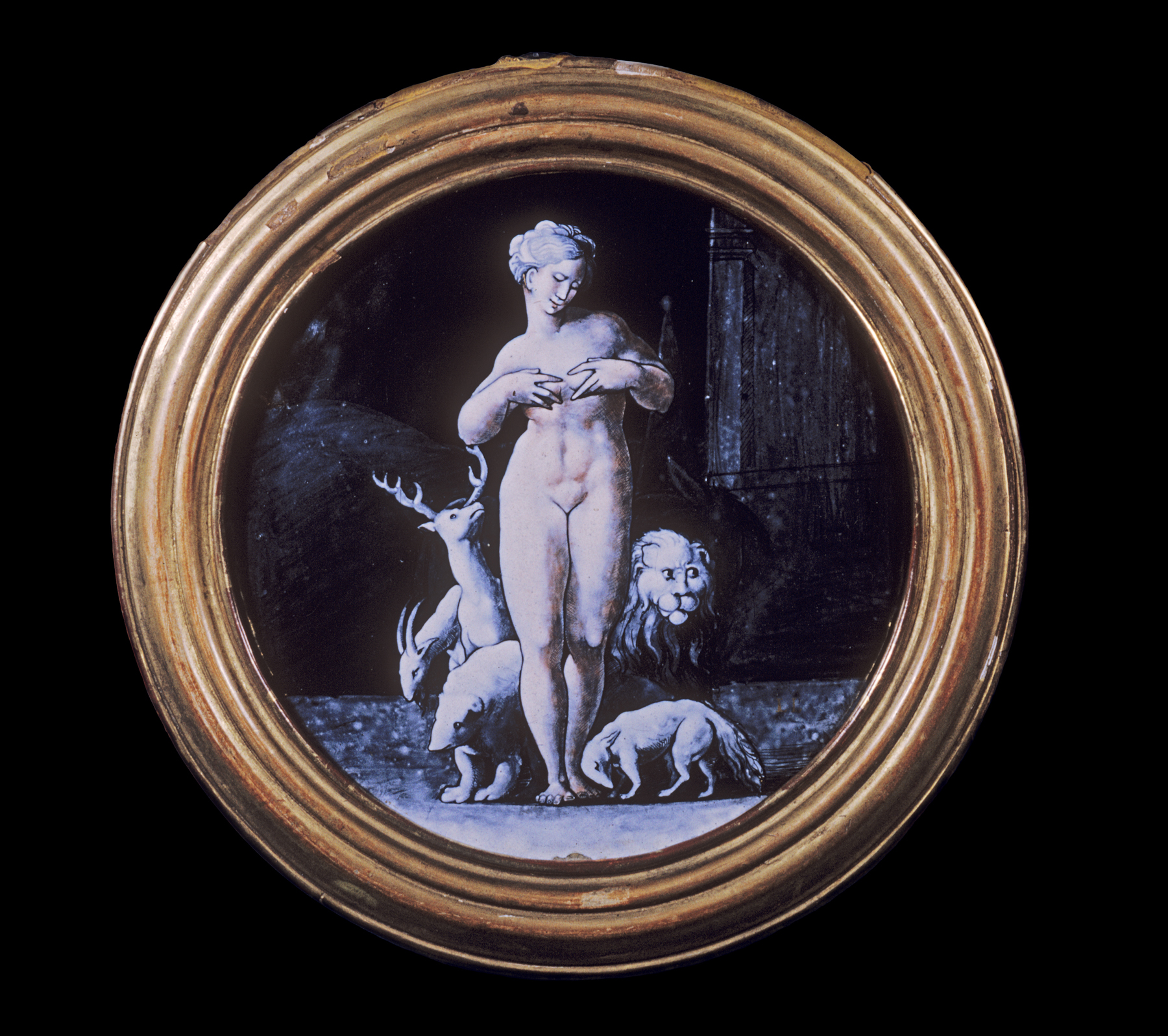Medallion with the Goddess Ops
(Renaissance Europe )
This medallion, signed by Leonard Limosin in gold on the lower right, portrays the goddess Ops, a personification of plentiful nature. Ops squeezes milk from her breasts to feed the beasts gathered at her feet: a goat, a deer, and a bear on the viewer’s left, and a lion and an ass on the right. In the background, a dark rocky formation is visible, as well as a pyramid and a shed with a pilaster. The strong profile and roundness of Ops’s body are accentuated by the clear drawing and silvery tones of the design. The medallion is executed in luminous grisaille (grayness), an effect popular with painters as well as enamellist that calls on the aesthetic qualities of marble sculpture. It emerged in Limoges enamels during the 1530s, and is achieved by building up the design in black and white enamel.
The composition is derived from a print engraved in 1526 by Jacopo Caraglio (1500-1565), after a composition drawn by the Italian painter Rosso Fiorentino (1495-1540). Fiorentino began working at the French royal court at Fontainebleau during the 1530s, and his paintings and engravings heavily influenced French artists. Though Limosin’s early designs were taken from prints by northern European artists like Albrecht Dürer (1471-528), by the time he made this medallion, he had begun to look more to the paintings and prints of the Italian Renaissance masters, as well as the French and Italian mannerists. Medallions or plaques of this scale could be set into furniture or woodwork to create a long-lasting decorative ensemble. For more on Limosin and his career, see 44.209. To see other works by the artist, click on his name in the creator field.
Provenance
Provenance (from the French provenir, 'to come from/forth') is the chronology of the ownership, custody, or location of a historical object. Learn more about provenance at the Walters.
Rattier Collection [date and mode of acquisition unknown]; Sale, Paris, March 21-24, 1859, lot 122; Charles Mannheim Collection [date and mode of acquisition unknown]; J. Pierpont Morgan, New York, no. 938; Arnold Seligmann, Rey & Co., New York [date and mode of acquisition unknown]; Henry Walters, Baltimore, 1919, by purchase; Walters Art Museum, 1931, by bequest.
Exhibitions
| 1987-1988 | Rosso Fiorentino: Drawings, Prints, and Decorative Arts. National Gallery of Art, Washington. |
| 1914 | Metropolitan Museum, New York, 1914. The Metropolitan Museum of Art, New York. |
| 1889 | Exposition rétrospective de l'art français au Trocadéro. Paris. |
Geographies
France, Limoges (Place of Origin)
Measurements
Diam: 8 3/4 in. (22.3 cm)
Credit Line
Acquired by Henry Walters, 1919
Location in Museum
Accession Number
In libraries, galleries, museums, and archives, an accession number is a unique identifier assigned to each object in the collection.
In libraries, galleries, museums, and archives, an accession number is a unique identifier assigned to each object in the collection.
44.218


